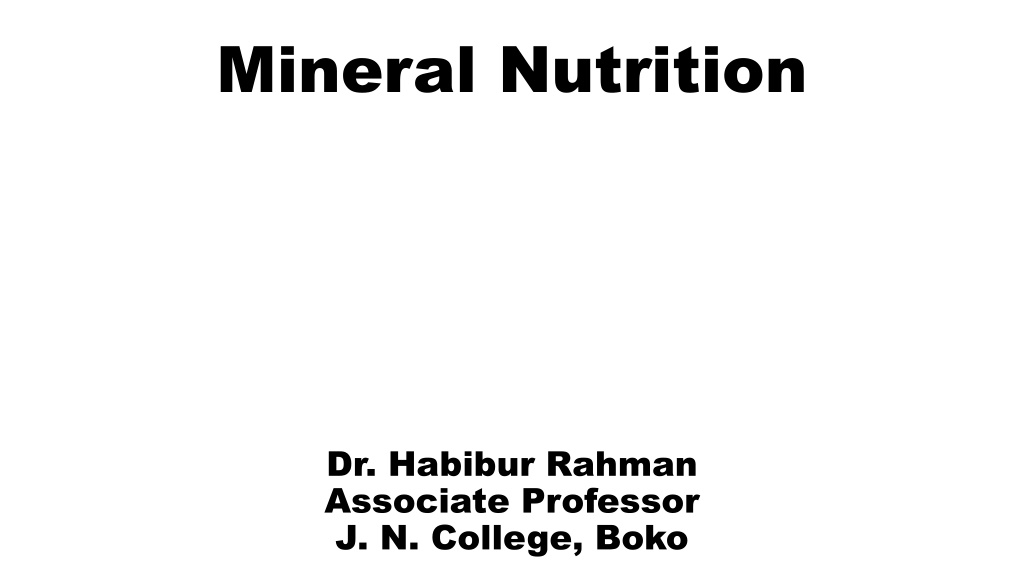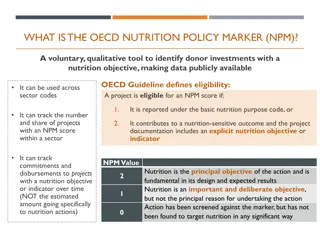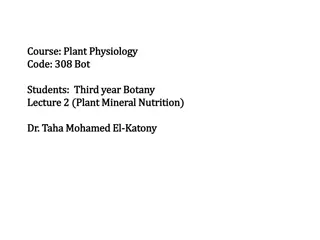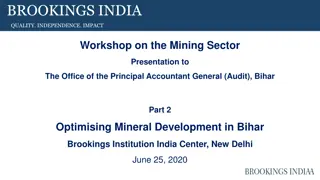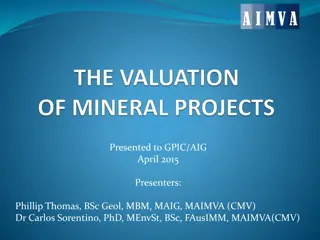Understanding Plant Mineral Nutrition: Importance and Study Methods
Plant nutrition involves the synthesis, breakdown, and utilization of food by plants for their growth and development. Mineral nutrition is a vital aspect, with plants obtaining essential nutrients from soil in the form of mineral elements. Methods like hydroponics have been used to study plant mineral requirements, deficiency symptoms, toxicity effects, and nutrient interactions, providing valuable insights for optimal plant growth.
Download Presentation

Please find below an Image/Link to download the presentation.
The content on the website is provided AS IS for your information and personal use only. It may not be sold, licensed, or shared on other websites without obtaining consent from the author. Download presentation by click this link. If you encounter any issues during the download, it is possible that the publisher has removed the file from their server.
E N D
Presentation Transcript
Mineral Nutrition Dr. Habibur Rahman Associate Professor J. N. College, Boko
WHAT IS PLANT NUTRITION ? grow and reproduce so every organism takes food and utilizes the food constituents for its requirements of growth. A series of processes are involved in the synthesis of food by plants, breaking down the food into simpler substances and utilization of these simpler substances for life processes. Nutrition in plants may thus be defined as a process of synthesis of food, its breakdown and utilisation for various functions in the body We know that all living organisms require food to survive,
Mineral Nutrition: Organisms require many organic and inorganic substances to complete their life cycle. All such substances which are taken from outside constitute their nutrition. On the basis of their nutritional requirements, organisms can be classified into heterotrophs and autotrophs. All non-green plants and animals, including human beings are heterotrophs. Autotrophic green plants obtain their nutrition from inorganic substances which are present in soil in the form of minerals, which are known as mineral elements or mineral nutrients and this type of nutrition is called mineral nutrition. The source of inorganic materials in the soil is minerals, they are called as mineral elements or mineral nutrients. The process involving the absorption, distribution and utilization of mineral substances by the plants for their growth and development is called mineral nutrition.
METHODS TO STUDY THE MINERAL REQUIREMENT OF PLANTS In 1860, Julius von Sachs, a prominent German botanist, demonstrated for the first time that plants could be grown to maturity in a defined nutrient solution in complete absence of soil. This technique of growing plants in a nutrient solution is known as hydroponics or soilless growth. After a series of experiments, in which the roots of the plants were immersed in nutrient solutions and wherein an element was added/ removed or given in varied concentration, a mineral solution suitable for the plant growth was obtained. By this method, essential elements were identified and their deficiency symptoms were discovered. Hydroponics has been successfully employed as a technique for the commercial production of vegetables such as tomato, seedless cucumber and lettuce. It must be emphasised that the nutrient solutions must be adequately aerated to obtain the optimum growth.
Because the plants are grown in large tanks, the process of soilless cultivation is also called as tank farming. Hydroponic culture solution was first prepared by Knop. The famous nutrient solutions are Knop solution, Hoagland solution, Arnon s solution and Sach s solution. Hydroponic or soilless culture helps in knowing i. the essentiality of mineral nutrients. ii. the deficiency symptoms developed due to non-availability of particular nutrients. iii.toxicity of plant when an element is present in excess. iv.the possible interaction among different elements present in plants. v. the role of essential elements in the metabolism of plants. Hydroponics is useful in areas having thin, infertile and dry soils. They conserve water, can regulate optimum pH for a particular crop, control pests and disease, avoid problems by weeding, reduces labour cost etc.
Mineral Elements in Plants On the basis of their effects on plant, mineral elements are generally of two types: i. Essential and ii. Non-essential. Elements which are required by plants for normal growth and development and without which plants cannot complete their life cycle are called essential elements. Deficiency of essential elements cause disorder as they are incorporated by plants in the formation of their structural or functional molecules. About 50-60 elements are present in plant body but only 16-17 elements are considered as essential elements. E.g., C, H, O, N, K, S, Ca, Fe, Mg, P, Cu, Mn, B, Cl, Zn, Mo, Ni Elements which are present in the plant body and are not required by plants are called non-essential elements. e.g., Na, Si, Al, Se, Sr, V.
According to Arnon, criteria of essentiality of minerals are given below : i. The element must be necessary for normal growth and reproduction of all plants. ii. The requirement of the element must be specific for plant life and can be replaced by any other element, that is the element is indispensable to the plant. iii.The elements must be directly involved in the metabolism of plant. iv.Arnon divided these necessary mineral elements into two groups on the basis of requirement of plant macronutrients and micronutrients.
Major element/Macronutrients : Its concentration must be 1-10 g L1/10m mole kg 1 of dry matter. E.g., C, H, O, N, K, S, Ca, Fe, Mg, P. Comparatively they are required in large amounts. C, H, O, N, P are the main constituents of protoplasm (organic materials). So they are called as protoplasmic elements. C & O from atmosphere and H2O are obtained from soil in mineral nutrition. C, H, O are main components of nucleic acid, proteins, enzymes, carbohydrates, fats (Framework elements). Minor element/Micronutrients : Its concentration is less than 1.0-0.1 g L 1/10m mole kg 1 of dry matter. E.g., Cu, Zn, Mn, B, Cl, Mo, Ni. Comparatively, they are required in less amount.
On the basis of function, essential elements are divided into 4 categories as: i. ii. components of energy related chemical compounds e.g., Mg in chlorophyll and phosphorus in ATP. iii. elements that activate or inhibit enzymes, e.g., Mg2+ activates ribulose bisphosphate carboxylase, oxygenase & phosphoenolpyruvate carboxylase. Zn2+ is an activator of alcohol dehydrogenase and Mo of nitrogenase during nitrogen metabolism. iv. essential elements that alter the osmotic potential of a cell, e.g., potassium (K) plays an important role in the opening & closing of stomata. components of biomolecules, e.g., C, H, O, N. Mineral elements other than essential elements which satisfies specific additional nutrient requirement of some specific plants are called beneficial nutrients.
Examples Na - Halophytes (e.g., Atriplex - Helps in C4 pathway) Si - Grasses (Provides mechanical strength) Se - Astragalus Co - Leguminous plants (Root nodule formation)
COMMON FUNCTIONS OF MINERALS: Constituent of protoplasm C, H, O, N, P, S are protoplasmic elements. Maintain the osmotic pressure of cell. In Redox reaction (In ETS) Fe, Mn, Cu, Cl. Antagonistic role (Balancing function) Ca, K neutralize the toxicity of harmful substances. Control of permeability of cell membrane Ca+, K+ As cofactors or activators Mg, Fe, Ca, Zn, Cu, K, Mn, Mo.
ROLE OF MACRO & MICRO NUTRIENTS: Essential elements perform several functions. Various forms and functions of mineral elements are - 1. Macronutrients Element: Carbon, Hydrogen and Oxygen: sense, they are still included in the list as they are most essential for plant life. These three elements are also called framework elements. Plants absorb them from air and soil in the form of carbon dioxide and water. Although these macronutrients elements are not minerals in the true
2. Macronutrients Element: Nitrogen: Soil is the chief source of nitrogen. It is absorbed from the soil in two major ionic forms: Nitrate (NO3-) and ammonium (NH ). Soils generally remain deficient in nitrogen, and soil fertility always depends on added nitrogen. Functions of Nitrogen: (i) The most recognized role of nitrogen in the plant is its presence in the structure of protein molecule. ii) It is the constituent of such important biomolecules like purines and pyrimidine s which are found in DNA and RNA. (iii) Nitrogen is found in the structure of porphyrin molecules which are the percursors of chlorophyll pigments and cytochromes that are essential in photosynthesis and respiration. (iv) The coenzymes like NAD+ , NADP+ , FAD, etc., are essential to the function of many enzymes and nitrogen is a structural component of these coenzymes. (v) Other compounds in the plant such as some vitamins contain nitrogen.
Deficiency Symptoms of Nitrogen: (i) A general chlorosis, i.e., the yellowing of leaves, especially in the older leaves, due to a loss in chlorophyll content appears first. In severe cases these leaves become completely yellow and then light tan as they die and frequently fall off the plant. (ii) This yellowing symptom appears last in the younger leaves, because they receive soluble forms of nitrogen transported from older leaves. (iii) In some cases production and accumulation of anthocyanin pigments is found. As a result a purplish colouration appears in stems, petioles, and lower leaf surfaces. (iv) The starch content is increased with the decrease in protein content. v) Plant growth remains stunted and lateral buds remain dormant. (vi) Flowering is suppressed or delayed; in the latter case the fruits and seeds are small and weak.
3. Macronutrients Element: Phosphorus: Phosphorus is very often the limiting nutrient in soils. It is present in the soil in inorganic and organic forms. It is absorbed as inorganic phosphate anions (H2PO4 ). Functions of Phosphorus: (i) It is a constituent of nucleic acids. Both DNA and RNA have a sugar-phosphate backbone in their structures. Triphosphate forms of nucleotides are precursors of nucleic acids. (ii) Phosphorus is a constituent of phospholipids or phosphoglycerides or glycerol phosphatides which along with proteins, are characteristic major components of cell membranes. (iii) Phosphorus is a constituent of the coenzymes NAD+ and NADP + , which take part in most of the cellular oxidation-reduction reactions involving hydrogen transfer. Most of the important metabolic processes like photosynthesis, respiration, nitrogen metabolism, carbohydrate metabolism, fatty-acid metabolism, etc., are dependent on the action of these coenzymes. (iv) Phosphorus is a constituent of ATP
Deficiency Symptoms of Phosphorus: (i) Phosphorus-deficient plants may develop dead necrotic areas on the leaves, petioles, or fruits. (ii) The plants show a general overall stunted appearance with often dark green colouration. (iii) Sometimes phosphorus deficiency may cause leaf-fall and purple or red anthocyanin pigmentation. (iv) The older leaves are usually affected first and become dark brown because of the mobility of phosphorus to the younger leaves under deficiency conditions. (v) Sometimes distortion in the shape of the leaves is observed and may be confused with zinc deficiency. (vi) Large amounts of pith and small amounts of vascular tissues are found in the stems of phosphorus-deficient tomato plants. (vii) In some cases a deficiency of this element causes an accumulation of carbohydrates.
Macronutrients Element: 4. Potassium: Potassium is present in the soil in soluble form, fixed or bound form and in an exchangeable form. Most of the potassium content of the soil is non- exchangeable (fixed) and, unavailable to the plant. Equilibrium exists in the soil between the three forms of potassium. Functions of Potassium: (a) Physiological Functions: (i) Potassium has been shown to be linked with carbohydrate metabolism. (ii) It is essential for translocation of sugar. (iii) Stomatal opening in higher plants requires potassium. If there is an influx of potassium ions (K+) into the guard cells during stomatal opening at the expense of ATP. Potassium accumulation in the guard-cell vacuole results in osmotic swelling of guard cell and stomatal opening. (iv) Potassium has a general role in the regulation of water in plant cells.
(b) Biochemical Functions: (i) The reactions, involved in the phosphorylation of carboxyl groups and inter-conversions of enolketo intermediates are activated by potassium. (ii) Potassium is required by the enzyme acetic thiokinase from spinach leaves for maximal activity. (iii) Potassium might act as a regulator of the enzyme pyruvate kinase through repression of synthesis of the enzyme. (iv) Folic acid metabolism has been shown to require potassium. (v) -glutamylcysteine synthesis specifically requires potassium. (vi) Nitrate reductase formation in rice seedlings specifically requires potassium.
Deficiency Symptoms of Potassium: (i) Due to easy mobility of potassium, deficiency symptoms first appear on older leaves. A mottled chlorosis followed by the development of dark necrotic lesions at the tip and margins of the leaf is generally found. The leaf-tips curve downwards and the margins roll inward towards the upper surface. (ii) In cereals, cells at the leaf-tip and margin die first, and the necrosis spreads basipetally toward the leaf bases. (iii) Potassium deficient cereal grains develop weak stalks, and their roots become susceptible to root rotting organisms. As a result, the plants easily get lodged by wind or rain. (iv) Generally, a potassium deficient plant exhibits stunted growth with shortened internodes. (v) Anatomically, potassium deficiency causes disintegration of pith cells and formation of secondary pholem in tomato plants.
Macronutrients Element 5. Magnesium: Magnesium is an exchangeable cation. It is present in the soil in water soluble, exchangeable, and fixed form. Magnesium is found to be present in soil abundantly as magnesium silicate, an unavailable form which becomes available to plants after weathering. Magnesium is absorbed as divalent Mg2 +. It may be available to plants from some fixed forms of minerals like magnesite (MgCO3), livine [(MgFe)2 SiO4], and dolomite (MgCO3.CaCO3). Of them dolomite is the most popular and economical source of magnesium fertilizer. Functions of Magnesium: Magnesium, like calcium, also serves as a structural component and is involved as a cofactor in many enzymatic reactions. (a) Structural Functions: (i) Magnesium is a component of the chlorophyll structure. (ii) Magnesium is required to maintain ribosome integrity.
(iii) Magnesium is necessary to maintain the structural integrity of chromatin fibre. It is involved in coiling of 110 thick DNA histone protein fibre to form a 300 thick chromatin fibre. (b) Physiological and Biochemical Functions: (i) Magnesium plays two very important roles in plant in photosynthesis and carbohydrate metabolism. (ii) The release of energy in the hydrolysis of high energy compounds like ATP is greatly influenced by Mg2+. It complexes with ATP, ADP and AMP with differing affinities, resulting in hydrolysis of these compounds. (iii) Mg2+ has also a direct role on potassium-sodium stimulated ATPase activity. (iv) Mg2+ is necessary for full activity of the two principal CO2 fixing enzymes, PEP carboxylase and RuBisCO. (v) Mg2 + is also an activator for DNA and RNA polymerases involved in DNA and RNA synthesis from nucleotide triphosphates. Thus Mg2 + helps in protein synthesis by activating enzymes of nucleic acid synthesis.
Deficiency Symptoms of Magnesium: (i) Extensive interveinal chlorosis of the older leaves is the first symptom, and as the deficiency becomes more acute, eventually reaches the younger leaves. This is because magnesium is a mobile element. (ii) Chlorosis is followed by anthocyanin pigmentation and then necrotic spotting. (iii) Anatomically magnesium deficiency causes extensive chlorenchyma development and scanty pith formation.
Micronutrients in plant growth.
Micronutrients: Micronutrients are those elements essential for plant growth which are needed in only very small quantities (equal to or less than 100 mg/kg of dry matter). These elements are sometime called minor or traced elements. The micronutrients are boron (B), iron (Fe), Chloride (Cl), manganese (Mn), nickel (Ni), sodium (Na), molybdenum (Mo) and zinc (Zn). Six of the micronutrients (iron, manganese, zinc, copper, nickel, and molybdenum) are associated with various plant enzymes, often as enzyme activators, and are involved in certain enzymatic reactions. Boron, present in cell walls, is also involved in nucleic acid metabolism and cell growth.
Trace elements can be conveniently divided into four groups: (a) The essential so far the following six have been conclusively proved to be essential for normal plant growth B, Zn, Cu, Mn, Mo and Co (b) The probably essential -elements like selenium, barium, etc. (c) The toxic all essential macro- and micronutrients in high dosages. [d) Physiologically inactive elements Arsenic, etc. 1. ZINC: Zn is an activator component for a host of enzymes, e.g., carbonic anhydrase (catalyses the reaction CO2 + H2O H ++ HCO 3), alcohol dehydrogenase, lactic dehydrogenase, glutamic dehydrogenase, triosephosphate dehydrogenase, aldolase (can be replaced by Co or Fe), etc.
It has been known for quite a long time that Zn is essential for the formation of the most important plant hormone, indole acetic acid. More recently it was shown that Zn in minute traces is indispensable for the formation of the amino acid, tryptophan, the generally accepted precursor of indole acetic acid and is not directly concerned with the synthesis of the auxin. The catabolic breakdown of tryptophan to, the indole nucleus of the auxin is accomplished by the enzyme tryptophanase. At the present moment, however, it is clear that the essentiality of Zn for the formation and breakdown of tryptophan is certainly due to its acting as an activator component of enzime tryptophanase. Zn Deficiency: i. Severe Zn deficiency effects on fruit trees. ii. Zn salts spray of a very dilute solution of ZnSO4 on the foliage of the trees. iii.Injection of solid salt containing a trace element into the trunk of the tree.
Zinc: It is important to plants for: Early growth stages. Development of root, seed and fruit. In the process of photosynthesis. Balancing plant hormones. Activity of auxins. Deficiency of Zinc results in stunted growth, length reduction of internodes, smaller young leaves, and yellowing on the lower leaves.
2. BORON: It is important for: Sugar transport Amino acid production Cell wall formation Crop reproduction Fruiting Flowering. Improvement of crop quality. Boron deficiency in plants can show various symptoms that include stunted growth of young crops, deformation of leaves, death of growing points, dark brown lesions on leaves, poor flowering and chlorosis or yellowing of leaves. It should be ensured that Boron application should be before the flowering stage in crops, applying later is not beneficial.
Iron (Fe): Iron is important for: Chlorophyll production. Photosynthesis Enzyme composition. Influences energy transfer, nitrogen reduction and fixation. Lignin formation. Deficiency in iron in plants harms younger leaves as it causes yellowing between the veins.
Manganese (Mn): It is important to plants for: Influences chloroplast production. Actively Participating in photosynthetic process. Activation of enzymes and influencing germination plus crop maturity. Deficiency in Mn also may lead to yellowing of veins in the younger leaves called chlorosis.
MECHANISM OF ABSORPTION OF ELEMENTS
Plants absorb a large number of minerals from soil. The uptake of mineral ions by the (sub-terminal) meristematic region of the roots. There are two methods of absorption of mineral salts : Passive and active. (a) Passive Absorption : It is the initial and rapid phase wherein ions are absorbed into the outerspace of the cells, through the apoplast pathway. It does not require use of any metabolic energy. (b) Active Absorption : It is the second phase of ion uptake. The ions are taken in slowly into the innerspace the symplast of cells. It needs the expenditure of metabolic energy. The movement of ions is called flux. When the ions move into the cells, it is called influx and the outward movement of ions is called efflux. The mineral ions absorbed by the root system are translocated through the xylem vessels to other parts of the plant.
PASSIVE ABSORPTION OF MINERALS (WITHOUT EXPENDITURE OF ATP) By simple diffusion : According to this method, mineral ions may diffuse in root cells from the soil solution. By mass flow : According to this method, mineral ion absorption occurs with the flow of water under the influence of transpiration. By ion exchange : This involves exchange of mineral ions with the ions of the same charge. i. By contact exchange : When the mineral ions exchange with the H+ and OH ions. ii. Carbonic acid exchange : When the mineral ions exchange with the ions of carbonic acid.
By Donnan equilibrium : This theory explains accumulation of ions against the concentration electrochemical potential (ECP) without ATP. At the inner side of the cell membrane separates from outside (external medium), there are some anions which are fixed or non-diffusible and membrane is impermeable to these anions, while cations are diffusible. the passive gradient or which
ACTIVE ION ABSORPTION (BY EXPENDITURE OF ATP) Evidences in favour of active mineral absorption are : Rate of respiration of plant is increased when the plant transferred into mineral solution (salt respiration). Factors like deficiency of oxygen, CO, CN(cyanide ion formula is CN ), which inhibit rate of respiration, also inhibit the absorption of mineral ions in plants. Absorption of K+ ions in Nitella algae is observed against the concentration gradient. Cytochrome pump theory : (By Lundegardh Burstorm, (1933)) According to this theory, only anions are absorbed by active mechanism through cytochrome pumping and absorption of cation is a passive process.
Carrier concept : (By Vanden honert) According to this theory, some specific carrier molecules made up of proteins are present in cell membrane of root cell which absorb both the ions and form ion- carrier complex. This complex breaks inside the cell membrane with expenditure of energy.
FACTORS AFFECTING MINERAL ABSORPTION The process of mineral absorption is influenced by the following factors like temperature, light etc. Temperature : The rate of absorption of salts and minerals is directly proportional to temperature. The absorption of mineral ions is inhibited when the temperature has reached its maximum limit, perhaps due to denaturation of enzymes. Light : When there is sufficient light, the more photosynthesis occurs. As a result, more food energy becomes available and salt uptake increases. Oxygen : A deficiency of O2 always causes a corresponding decrease in the rate of mineral absorption. It is probably due to unavailability of ATP. The increased oxygen tension helps in increased uptake of salts.
pH : It affects the rate of mineral absorption by regulating the availability of ions in the medium. At normal physiological pH, monovalent ions are absorbed more rapidly whereas alkaline pH favours the absorption of bivalent and trivalent ions. Interaction with other minerals : The absorption of one type of ions is affected by other type. The absorption of K+ is affected by Ca++, Mg++ and other polyvalent ions. It is probably due to competition for binding sites on the carrier. However, the uptake of K+ and Br becomes possible in presence of Ca++ ions. There is a mutual competition in the absorption of K, Rb and Cs ions.(Rubidium(1+) is a monovalent inorganic cation, Caesium(1+) is a caesium ion, a monovalent inorganic cation) Growth : A proper growth causes an increase in surface area, the number of cells and in the number of binding sites for the mineral ions. As a result, mineral absorption is enhanced.
